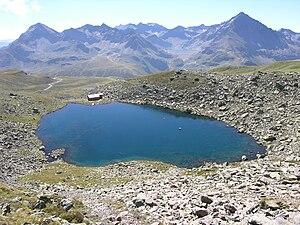Gossenköllesee
| Gossenköllesee | ||
|---|---|---|

|
||
| Geographical location | Tyrol , Austria | |
| Location close to the shore | Kühtai | |
| Data | ||
| Coordinates | 47 ° 13 '46 " N , 11 ° 0' 50" E | |
|
|
||
| Altitude above sea level | 2413 m above sea level A. | |
| surface | 1.5 ha | |
| Maximum depth | 9 m | |
| Middle deep | 4.6 m | |
| Catchment area | 85 ha | |
The Gossenköllesee is a mountain lake above the Kühtaisattel in a cirque below the Pirchkogel in the Stubai Alps .
location
The only 1.6 hectare Gossenköllesee in Kühtai at 2417 m is located directly below the Pirchkogel. It is only a little northeast of the Schwarzmoos lift , well hidden from the gaze of piste skiers by a moraine deposited after the last ice age .
research
fitness
High mountain lakes like this one are very well suited for the investigation of globally effective processes, as they have no direct human interference and relatively simple food webs and are extremely sensitive to changes in the catchment area and in the atmosphere . On the one hand they represent early warning systems for environmental changes, on the other hand they are also historical archives whose sediment layers reflect their history since the last ice age. At low altitudes, on the other hand, lakes are hardly suitable as indicators of global changes due to the various human influences.
This small lake is one of the best observed domestic high mountain lakes and plays a central role in numerous international scientific research projects. It is one of the few high mountain lakes in Europe with a well-equipped research station (of the University of Innsbruck ) on the banks of which can be reached easily and safely all year round and which functions without emissions.
meaning
At a time when natural ecosystems are disappearing at a rapid pace, the Gossenköllesee area with its largely intact natural landscape occupies an internationally almost unique position. A big advantage is that the area does not have any direct human influence - the ski area is not in the immediate vicinity, there are no roads passing by and there is no refuge in the catchment area. The Gossenköllesee is mainly influenced by the atmosphere , above all by precipitation , dust and temperature increases . The construction of lifts through the research area would not only destroy a beautiful alpine natural landscape, it would also mean for research to bury long-term valuable data series again and start again at a different point from zero. Not only would highly qualified jobs be endangered, the reputation of Austrian research and the University of Innsbruck would also be seriously damaged. Incidentally, it is almost hopeless to find a comparable location in Tyrol that can meet the criteria for secure, long-term research.
ecology
The first limnological investigations took place in 1933. A research station of the University of Innsbruck has been located at the lake since 1975 , which means that the lake has been studied very intensively. The original research station was built in 1959 on the south bank of the Vorderen Finstertal lake , but had to give way to the Finstertal reservoir of the Sellrain-Silz power plant group . In order to keep the scientific investigations free from human influences, the Gossenköllesee with its catchment area was designated as a UNESCO biosphere reserve from 1977 to 2014 . In 2015 he was accepted into the GLEON research network .
The lake lies above the tree line and is usually covered by a layer of ice and snow up to two meters thick from the beginning of November to mid-June, which has a decisive influence on the incidence of light and the exchange of nutrients. The lake is low in nutrients and is classified as oligotrophic . Due to the extreme living conditions, it is naturally poor in species. A special feature is the occurrence of a diatom species of the genus Fragilaria , which has not yet been detected in any other high mountain lake. In addition, brown trout can be found in the lake , which Emperor Maximilian I had brought in around 1500 together with char , as in many other mountain lakes. While brown trout are genetic hybrid forms everywhere today, the fish in Gossenköllesee come exclusively from the Danube catchment area.
Individual evidence
- ↑ a b c d e Gossenköllesee. Institute for Ecology at the University of Innsbruck , accessed on July 6, 2015 .
- ↑ a b The Gossenköllesee. In: Sigrun Lange: Life in Diversity. UNESCO biosphere reserves as model regions for the coexistence of man and nature. Austrian Academy of Sciences, Vienna 2005, pp. 80–83, doi : 10.1553 / 3-7001-3337-5s80
- ↑ a b c Johann Zauner: Silz. Nature, HOME, culture, past and present . Ed .: Municipality of Silz. Widumgasse 1 2015, p. 98-101 .
- ↑ a b Focus on Austria's only high alpine lake. The July 3, 2015 standard, accessed July 6, 2015 .
